The TECH Cooking Studio event was held for the third time at Hisao & Hiroko Taki Plaza (Taki Plaza) on Ookayama Campus on December 13. Joining in the fun to learn about ozoni, a Japanese soup dish traditionally enjoyed around the New Year holidays, were Japanese and international students from over 10 countries and regions. Leading the lecture and preparation of the versatile broth was Hiroko Kasuya, a true ozoni enthusiast and researcher.

Ozoni expert Kasuya lecturing on Japanese food culture
This event was again held as part of the Student Success Support Project, an initiative supported by Gurunavi Inc. Chairman and Director Hisao Taki, a Tokyo Tech alumnus. As in previous years, the event was co-organized by the Student Support Center’s Student Success Support Section, the Student Support Division’s Support Planning Group, and the Tokyo Tech Alumni Association.
Part One: Lecture on ozoni from various regions of Japan and cooking demonstration
Part One of TECH Cooking Studio focused on learning about different types of ozoni from expert Kasuya. This component of the event was moderated in English and Japanese by student organizers Risako Yanagase and Teru Hashimoto, both of whom are 1st-year master’s students.

Student moderators Yanagase (left) and Hashimoto
During her lecture, Kasuya spoke about ozoni soup stock and ingredients used in various regions of Japan, and explained the origins of the ingredients used in the dish. She also talked about the rough geographical line where the shape of the mochi rice cake changes from round in western Japan to square-shaped in the east. Kasuya herself noticed this interesting regional difference after moving around Japan every year or two to study ozoni.
The presentation materials provided by Kasuya were translated into English by student organizers and projected onto a screen so that non-Japanese speaking participants could follow the talk more easily. Simultaneous interpretation was provided by Miki Miki, a student life coach at the Student Support Center’s Student Success Support Section, helping to clarify unfamiliar words and nuances unique to the Japanese language.
After the lecture, Kasuya demonstrated ways to cut soup ingredients in different regions, and touched on some beliefs related to these cutting methods. For example, slicing ingredients into a circular shape is believed to bring family happiness and allow things to settle down in a roundabout way.
Two lucky participants also got to try a sweet ozoni made with white miso paste, which is unique to the Kansai region, including Kasuya’s home of Kagawa Prefecture. As Kasuya prepared the delicacy, many participants saw anko mochi — rice cake filled with sweet bean paste — for the first time.
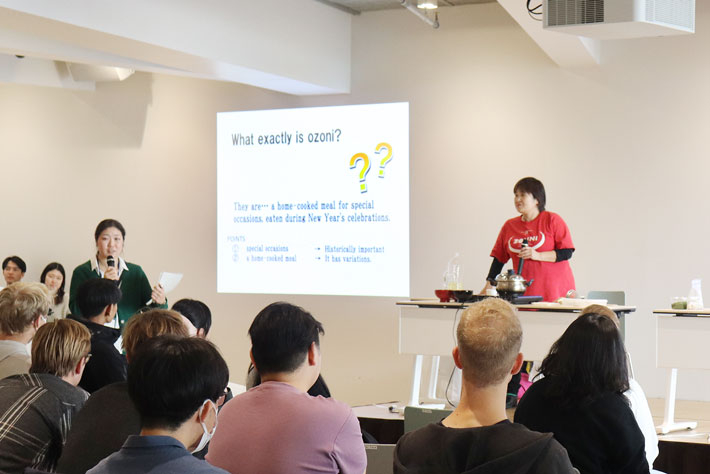
Kasuya demonstrating ways to cut ingredients
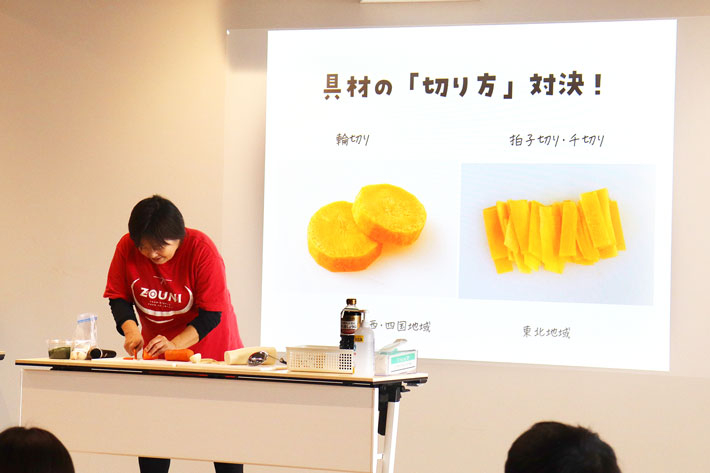
Student life coach Miki (left) interpreting Kasuya’s talk
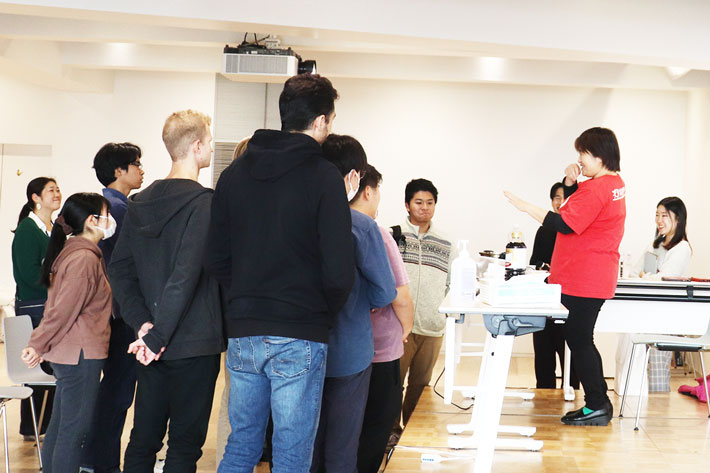
Participants learning about mochi rice cake
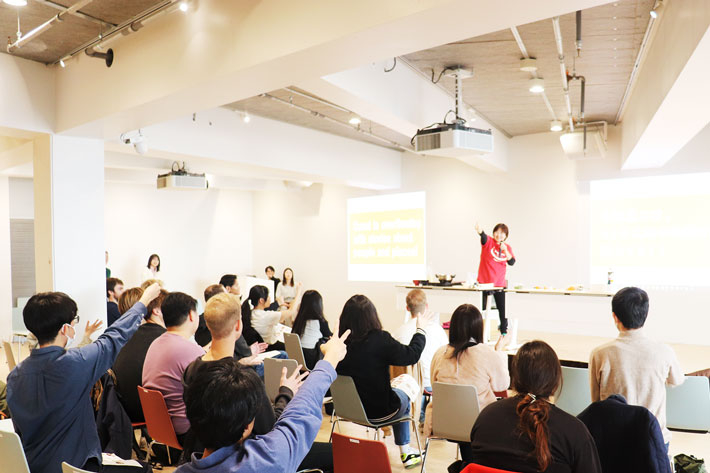
Rock-paper-scissors to determine two lucky tasters
Part Two: Tasting event at second cafeteria
For Part Two of TECH Cooking Studio, the participants moved to the Second Cafeteria on Ookayama Campus where they were invited to taste ozoni common in the Kanto region. This event was held in cooperation with the University Co-op. The traditional soup, which contained freshly cooked rice cake topped with Japanese mustard spinach, carrot, and fish paste prepared in advance, was so popular among the international students that there was a constant line of people waiting for a second helping. One of the students tasting the white miso ozoni from Kansai said that it was similar to a sweet chicken soup served in Indonesia. While enjoying their food, the participants creating a memorable time together by sharing culinary traditions from their home countries and regions.
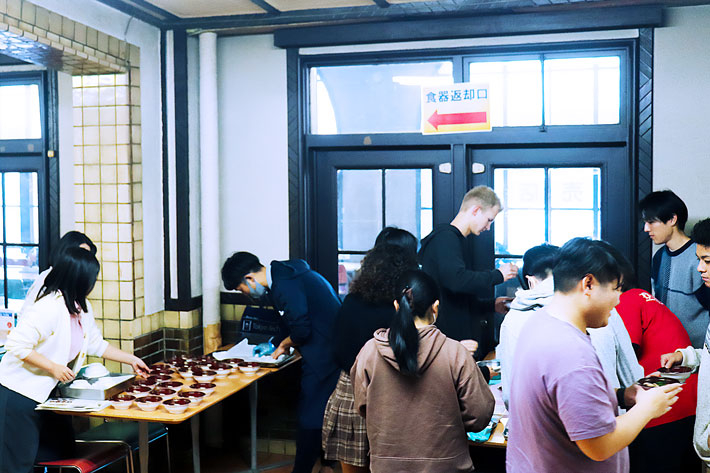
Participants tasting ozoni from Kanto region
As ozoni is traditionally a homemade New Year’s dish, international students rarely have the opportunity to try it. Japanese students seldom eat it outside their family homes. This event offered a great chance for all students to not only try this Japanese New Year dish, but also learn about the culinary characteristics and tastes of various regions in the country.
Comments from participants
-
Good food, nice to learn about the traditions.
-
The explanations about the different types of ozoni were easy to understand, and of course the dish we tried was delicious!
-
I never had a New Year’s dish before, there’s nothing like this in my country.
-
It was very interesting. We learned many things that even Japanese people probably did not know.
Comments from Student Success Support Project student organizers
Risako Yanagase
1st-year master’s student, Transdisciplinary Science and Engineering
This was the third TECH Cooking Studio we organized, but the first time we focused on a meal rather than sweets. Although ozoni is a familiar dish to those who were born and raised in Japan, international students do not have many opportunities to experience it. We thought it would also be interesting for Japanese participants since this dish varies significantly depending on the region in which it is served.
Many of the participants were international students, and we were a bit anxious about whether the food would suit their palates. In the end, I was impressed by how popular the food was! When we announced that we had time to serve a second cup of soup, many international students stood up to ask for seconds, and I really felt both joy and a sense of pride in Japanese culture. It was also great to see that students seated in the same table during the tasting actually stayed behind to continue their conversations after the event.
I am planning to study abroad next academic year, and I hope to use what I have learned through this event to introduce Japanese culture to new friends at my overseas destination.
I would like to express my sincere appreciation to all the faculty and staff who assisted in the planning and execution of this event. We look forward to your warm support and cooperation in future events.
Ryota Uehara
1st-year master’s student, Materials Science and Engineering
At this event, Hiroko Kasuya, an ozoni researcher, gave an interesting talk about ozoni culture in various regions of Japan. Throughout the lecture, she talked not only about the unique forms of ozoni in different areas, but also shared episodes from her personal experiences. All the participants listened to the stories with great interest. There were many things in the lectures that I had never heard before, so I think the event was fruitful not only for international students unfamiliar with Japanese food, but also for Japanese students. During the tasting in the cafeteria, the participants seemed to enjoy talking while sipping their soup. It was a great overall vibe, and some participants liked the ozoni so much they had second and even third servings.
I only learned about the existence of research on ozoni through this event, and it has encouraged me to rethink my research activities. I would like to use this experience to broaden my scope as a researcher.
I would like to thank the faculty and staff for their generous support in organizing this event. We look forward to your continued support in the future.
Namkyong Kim
3rd year, Materials Science and Engineering
I am glad this event was enjoyable for so many people, including international students who got their first taste of ozoni and Japanese students who learned about the differences in ozoni across Japan. I knew that the dish is eaten around the turn of the New Year, but I had never had a chance to try it because it is traditionally a homemade dish.
I sensed an air of diversity during the event as international students could taste this traditional dish, but Japanese students also learned about ozoni that differed from what they were used to. While enjoying and talking about the dish, many international students also shared stories about culinary traditions in their home regions during the year-end and New Year’s holidays.
There were many international students present, and I was slightly worried about conveying the ingredients and dishes accurately, as many of them were difficult even for Japanese to understand. However, thanks to the faculty, staff, and student organizers, I think we did a pretty good job as we used English slides and simultaneous interpretation to communicate the message.
As I listened to Ms. Kasuya’s talk about her research on ozoni, I was very impressed by her attention to even the smallest details, and her enthusiasm to work in the field. It made me feel like I should also focus on more details in my future research activities, and to carry out more experiments and investigations independently.
Teru Hashimoto
1st-year master’s student, Transdisciplinary Science and Engineering
As student organizers in the Student Success Support Project, we planned and promoted the event, set up the venue on the day, moderated the event, took photos, and handled all kinds of things. It was quite a bit of work as this event followed the English rakugo event we organized the previous week, but I am very glad that everything went smoothly. Before the event, my experiences with ozoni were limited to a few meals during past New Year holidays. However, I realized that ozoni has plenty of appeal. For example, having only experienced round mochi during the New Year at my grandmother’s house in the Kansai region, I would have never guessed that ozoni in the Kanto region contains square rice cakes.
According to Ms. Kasuya, the ingredients of ozoni differ from those of neighboring towns due to geographical factors such as mountains. In the past, ingredients also varied regionally due to the orders of the shogun. I felt like I learned about many aspects that were somehow related to my studies at Tokyo Tech. Based on the participants’ expressions as they listened to Ms. Kasuya’s talk, I think they also truly enjoyed this event.
I would like to thank the ozoni researcher Hiroko Kasuya, as well as all the staff and faculty members for their cooperation in this project. We will continue to work hard as student organizers and look forward to working with various people in the future.
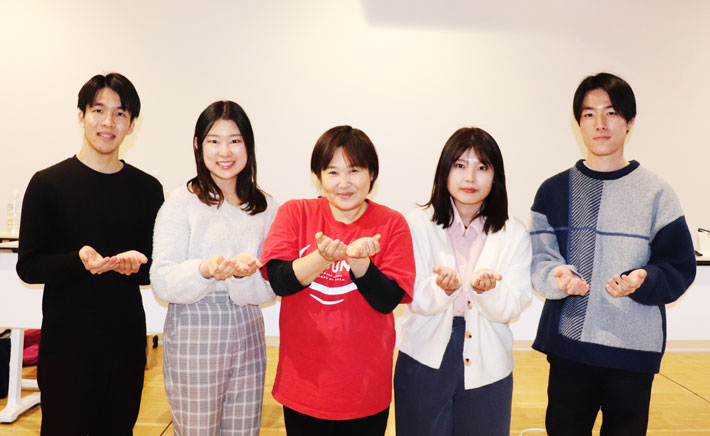
Kasuya (center) with Student Success Support Project student organizers
Tokyo Tech’s Student Success Support Project organizers are already looking forward to creating another appetizing, interactive event through the next TECH Cooking Studio.





































